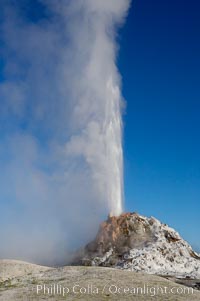
White Dome Geyser rises to a height of 30 feet or more, and typically erupts with an interval of 15 to 30 minutes. It is located along Firehole Lake Drive.
Location: Lower Geyser Basin, Yellowstone National Park, Wyoming
Image ID: 13546
Location: Lower Geyser Basin, Yellowstone National Park, Wyoming
Image ID: 13546
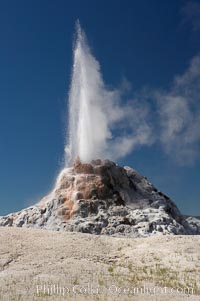
White Dome Geyser rises to a height of 30 feet or more, and typically erupts with an interval of 15 to 30 minutes. It is located along Firehole Lake Drive.
Location: Lower Geyser Basin, Yellowstone National Park, Wyoming
Image ID: 13547
Location: Lower Geyser Basin, Yellowstone National Park, Wyoming
Image ID: 13547
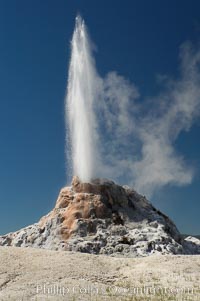
White Dome Geyser rises to a height of 30 feet or more, and typically erupts with an interval of 15 to 30 minutes. It is located along Firehole Lake Drive.
Location: Lower Geyser Basin, Yellowstone National Park, Wyoming
Image ID: 13548
Location: Lower Geyser Basin, Yellowstone National Park, Wyoming
Image ID: 13548
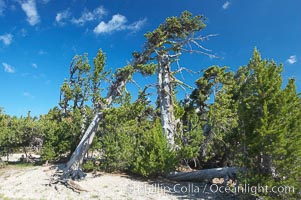
Whitebark pine, Crater Lake, Oregon. Due to harsh, almost constant winds, whitebark pines along the crater rim surrounding Crater Lake are often deformed and stunted.
Species: Whitebark pine, Pinus albicaulis
Location: Crater Lake National Park, Oregon
Image ID: 13945
Species: Whitebark pine, Pinus albicaulis
Location: Crater Lake National Park, Oregon
Image ID: 13945
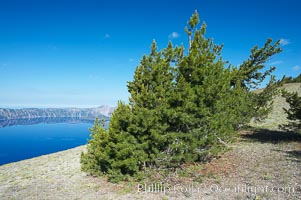
Whitebark pine, Crater Lake, Oregon. Due to harsh, almost constant winds, whitebark pines along the crater rim surrounding Crater Lake are often deformed and stunted.
Species: Whitebark pine, Pinus albicaulis
Location: Crater Lake National Park, Oregon
Image ID: 13946
Species: Whitebark pine, Pinus albicaulis
Location: Crater Lake National Park, Oregon
Image ID: 13946
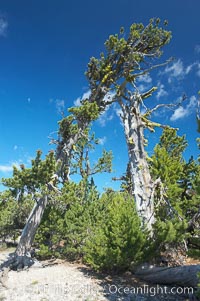
Whitebark pine, Crater Lake, Oregon. Due to harsh, almost constant winds, whitebark pines along the crater rim surrounding Crater Lake are often deformed and stunted.
Species: Whitebark pine, Pinus albicaulis
Location: Crater Lake National Park, Oregon
Image ID: 13947
Species: Whitebark pine, Pinus albicaulis
Location: Crater Lake National Park, Oregon
Image ID: 13947
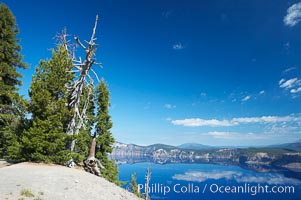
Whitebark pine, Crater Lake, Oregon. Due to harsh, almost constant winds, whitebark pines along the crater rim surrounding Crater Lake are often deformed and stunted.
Species: Whitebark pine, Pinus albicaulis
Location: Crater Lake National Park, Oregon
Image ID: 13948
Species: Whitebark pine, Pinus albicaulis
Location: Crater Lake National Park, Oregon
Image ID: 13948
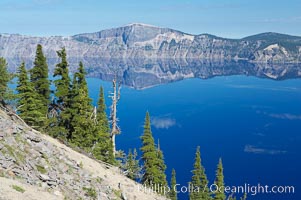
Whitebark pine, Crater Lake, Oregon. Due to harsh, almost constant winds, whitebark pines along the crater rim surrounding Crater Lake are often deformed and stunted.
Species: Whitebark pine, Pinus albicaulis
Location: Crater Lake National Park, Oregon
Image ID: 13949
Species: Whitebark pine, Pinus albicaulis
Location: Crater Lake National Park, Oregon
Image ID: 13949
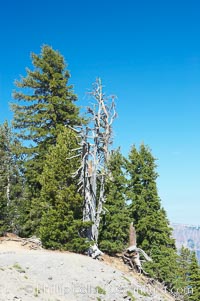
Whitebark pine, Crater Lake, Oregon. Due to harsh, almost constant winds, whitebark pines along the crater rim surrounding Crater Lake are often deformed and stunted.
Species: Whitebark pine, Pinus albicaulis
Location: Crater Lake National Park, Oregon
Image ID: 13950
Species: Whitebark pine, Pinus albicaulis
Location: Crater Lake National Park, Oregon
Image ID: 13950
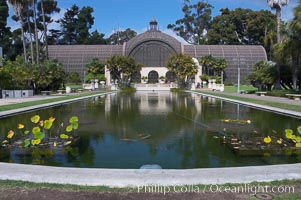
The Botanical Building in Balboa Park, San Diego. The Botanical Building, at 250 feet long by 75 feet wide and 60 feet tall, was the largest wood lath structure in the world when it was built in 1915 for the Panama-California Exposition. The Botanical Building, located on the Prado, west of the Museum of Art, contains about 2,100 permanent tropical plants along with changing seasonal flowers. The Lily Pond, just south of the Botanical Building, is an eloquent example of the use of reflecting pools to enhance architecture. The 193 by 43 foot pond and smaller companion pool were originally referred to as Las Lagunas de las Flores (The Lakes of the Flowers) and were designed as aquatic gardens. The pools contain exotic water lilies and lotus which bloom spring through fall. Balboa Park, San Diego.
Location: Balboa Park, San Diego, California
Image ID: 14575
Location: Balboa Park, San Diego, California
Image ID: 14575
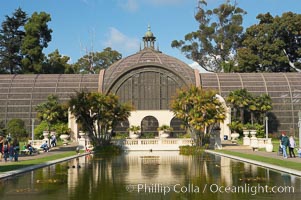
The Botanical Building in Balboa Park, San Diego. The Botanical Building, at 250 feet long by 75 feet wide and 60 feet tall, was the largest wood lath structure in the world when it was built in 1915 for the Panama-California Exposition. The Botanical Building, located on the Prado, west of the Museum of Art, contains about 2,100 permanent tropical plants along with changing seasonal flowers. The Lily Pond, just south of the Botanical Building, is an eloquent example of the use of reflecting pools to enhance architecture. The 193 by 43 foot pond and smaller companion pool were originally referred to as Las Lagunas de las Flores (The Lakes of the Flowers) and were designed as aquatic gardens. The pools contain exotic water lilies and lotus which bloom spring through fall. Balboa Park, San Diego.
Location: Balboa Park, San Diego, California
Image ID: 14576
Location: Balboa Park, San Diego, California
Image ID: 14576
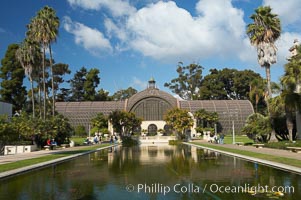
The Botanical Building in Balboa Park, San Diego. The Botanical Building, at 250 feet long by 75 feet wide and 60 feet tall, was the largest wood lath structure in the world when it was built in 1915 for the Panama-California Exposition. The Botanical Building, located on the Prado, west of the Museum of Art, contains about 2,100 permanent tropical plants along with changing seasonal flowers. The Lily Pond, just south of the Botanical Building, is an eloquent example of the use of reflecting pools to enhance architecture. The 193 by 43 foot pond and smaller companion pool were originally referred to as Las Lagunas de las Flores (The Lakes of the Flowers) and were designed as aquatic gardens. The pools contain exotic water lilies and lotus which bloom spring through fall. Balboa Park, San Diego.
Location: Balboa Park, San Diego, California
Image ID: 14577
Location: Balboa Park, San Diego, California
Image ID: 14577
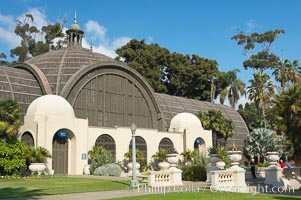
The Botanical Building in Balboa Park, San Diego. The Botanical Building, at 250 feet long by 75 feet wide and 60 feet tall, was the largest wood lath structure in the world when it was built in 1915 for the Panama-California Exposition. The Botanical Building, located on the Prado, west of the Museum of Art, contains about 2,100 permanent tropical plants along with changing seasonal flowers. The Lily Pond, just south of the Botanical Building, is an eloquent example of the use of reflecting pools to enhance architecture. The 193 by 43 foot pond and smaller companion pool were originally referred to as Las Lagunas de las Flores (The Lakes of the Flowers) and were designed as aquatic gardens. The pools contain exotic water lilies and lotus which bloom spring through fall. Balboa Park, San Diego.
Location: Balboa Park, San Diego, California
Image ID: 14579
Location: Balboa Park, San Diego, California
Image ID: 14579
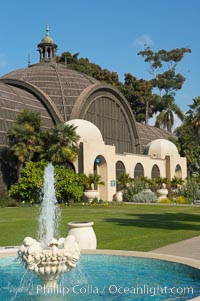
The Botanical Building in Balboa Park, San Diego. The Botanical Building, at 250 feet long by 75 feet wide and 60 feet tall, was the largest wood lath structure in the world when it was built in 1915 for the Panama-California Exposition. The Botanical Building, located on the Prado, west of the Museum of Art, contains about 2,100 permanent tropical plants along with changing seasonal flowers. The Lily Pond, just south of the Botanical Building, is an eloquent example of the use of reflecting pools to enhance architecture. The 193 by 43 foot pond and smaller companion pool were originally referred to as Las Lagunas de las Flores (The Lakes of the Flowers) and were designed as aquatic gardens. The pools contain exotic water lilies and lotus which bloom spring through fall. Balboa Park, San Diego.
Location: Balboa Park, San Diego, California
Image ID: 14580
Location: Balboa Park, San Diego, California
Image ID: 14580
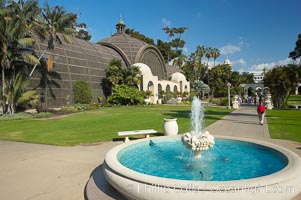
The Botanical Building in Balboa Park, San Diego. The Botanical Building, at 250 feet long by 75 feet wide and 60 feet tall, was the largest wood lath structure in the world when it was built in 1915 for the Panama-California Exposition. The Botanical Building, located on the Prado, west of the Museum of Art, contains about 2,100 permanent tropical plants along with changing seasonal flowers. The Lily Pond, just south of the Botanical Building, is an eloquent example of the use of reflecting pools to enhance architecture. The 193 by 43 foot pond and smaller companion pool were originally referred to as Las Lagunas de las Flores (The Lakes of the Flowers) and were designed as aquatic gardens. The pools contain exotic water lilies and lotus which bloom spring through fall. Balboa Park, San Diego.
Location: Balboa Park, San Diego, California
Image ID: 14581
Location: Balboa Park, San Diego, California
Image ID: 14581
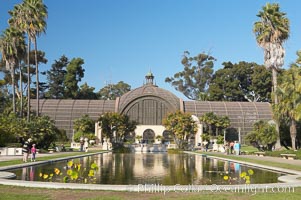
The Botanical Building in Balboa Park, San Diego. The Botanical Building, at 250 feet long by 75 feet wide and 60 feet tall, was the largest wood lath structure in the world when it was built in 1915 for the Panama-California Exposition. The Botanical Building, located on the Prado, west of the Museum of Art, contains about 2,100 permanent tropical plants along with changing seasonal flowers. The Lily Pond, just south of the Botanical Building, is an eloquent example of the use of reflecting pools to enhance architecture. The 193 by 43 foot pond and smaller companion pool were originally referred to as Las Lagunas de las Flores (The Lakes of the Flowers) and were designed as aquatic gardens. The pools contain exotic water lilies and lotus which bloom spring through fall. Balboa Park, San Diego.
Location: Balboa Park, San Diego, California
Image ID: 14583
Location: Balboa Park, San Diego, California
Image ID: 14583
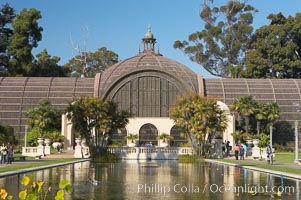
The Botanical Building in Balboa Park, San Diego. The Botanical Building, at 250 feet long by 75 feet wide and 60 feet tall, was the largest wood lath structure in the world when it was built in 1915 for the Panama-California Exposition. The Botanical Building, located on the Prado, west of the Museum of Art, contains about 2,100 permanent tropical plants along with changing seasonal flowers. The Lily Pond, just south of the Botanical Building, is an eloquent example of the use of reflecting pools to enhance architecture. The 193 by 43 foot pond and smaller companion pool were originally referred to as Las Lagunas de las Flores (The Lakes of the Flowers) and were designed as aquatic gardens. The pools contain exotic water lilies and lotus which bloom spring through fall. Balboa Park, San Diego.
Location: Balboa Park, San Diego, California
Image ID: 14584
Location: Balboa Park, San Diego, California
Image ID: 14584

Brown bear walks along the edge of Brooks Lake.
Species: Brown bear, Ursus arctos
Location: Brooks River, Katmai National Park, Alaska
Image ID: 17063
Species: Brown bear, Ursus arctos
Location: Brooks River, Katmai National Park, Alaska
Image ID: 17063

Brown bear walks along the edge of Brooks Lake.
Species: Brown bear, Ursus arctos
Location: Brooks River, Katmai National Park, Alaska
Image ID: 17067
Species: Brown bear, Ursus arctos
Location: Brooks River, Katmai National Park, Alaska
Image ID: 17067
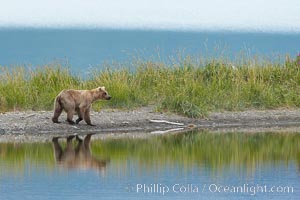
Brown bear is reflected in the Brooks River along the edge of Brooks Lake.
Species: Brown bear, Ursus arctos
Location: Brooks River, Katmai National Park, Alaska
Image ID: 17071
Species: Brown bear, Ursus arctos
Location: Brooks River, Katmai National Park, Alaska
Image ID: 17071

Brown bear walks along a sand spit, Brooks Lake.
Species: Brown bear, Ursus arctos
Location: Brooks River, Katmai National Park, Alaska
Image ID: 17117
Species: Brown bear, Ursus arctos
Location: Brooks River, Katmai National Park, Alaska
Image ID: 17117
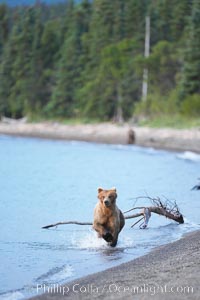
Brown bear along the edge of Brooks Lake.
Species: Brown bear, Ursus arctos
Location: Brooks River, Katmai National Park, Alaska
Image ID: 17119
Species: Brown bear, Ursus arctos
Location: Brooks River, Katmai National Park, Alaska
Image ID: 17119
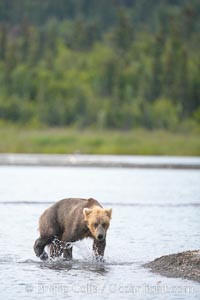
Brown bear walks along the edge of Brooks Lake.
Species: Brown bear, Ursus arctos
Location: Brooks River, Katmai National Park, Alaska
Image ID: 17200
Species: Brown bear, Ursus arctos
Location: Brooks River, Katmai National Park, Alaska
Image ID: 17200
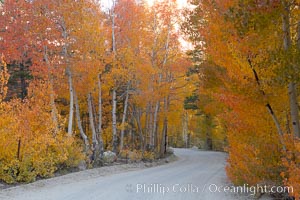
Aspen trees displaying fall colors rise alongside a High Sierra road near North Lake, Bishop Creek Canyon.
Species: Aspen, Populus tremuloides
Location: Bishop Creek Canyon, Sierra Nevada Mountains, California
Image ID: 17537
Species: Aspen, Populus tremuloides
Location: Bishop Creek Canyon, Sierra Nevada Mountains, California
Image ID: 17537
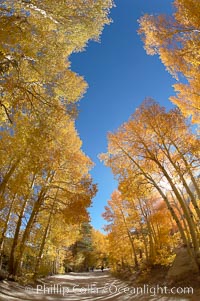
Aspen trees displaying fall colors rise alongside a High Sierra road near North Lake, Bishop Creek Canyon.
Species: Aspen, Populus tremuloides
Location: Bishop Creek Canyon, Sierra Nevada Mountains, California
Image ID: 17556
Species: Aspen, Populus tremuloides
Location: Bishop Creek Canyon, Sierra Nevada Mountains, California
Image ID: 17556
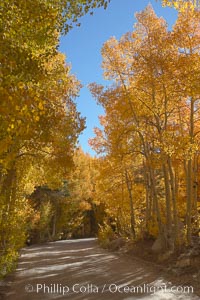
Aspen trees displaying fall colors rise alongside a High Sierra road near North Lake, Bishop Creek Canyon.
Species: Aspen, Populus tremuloides
Location: Bishop Creek Canyon, Sierra Nevada Mountains, California
Image ID: 17562
Species: Aspen, Populus tremuloides
Location: Bishop Creek Canyon, Sierra Nevada Mountains, California
Image ID: 17562
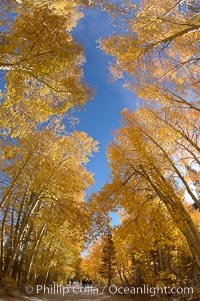
Aspen trees displaying fall colors rise alongside a High Sierra road near North Lake, Bishop Creek Canyon.
Species: Aspen, Populus tremuloides
Location: Bishop Creek Canyon, Sierra Nevada Mountains, California
Image ID: 17563
Species: Aspen, Populus tremuloides
Location: Bishop Creek Canyon, Sierra Nevada Mountains, California
Image ID: 17563
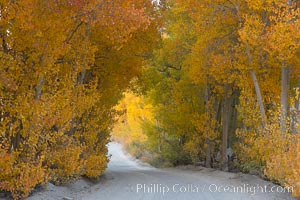
Aspen trees displaying fall colors rise alongside a High Sierra road near North Lake, Bishop Creek Canyon.
Species: Aspen, Populus tremuloides
Location: Bishop Creek Canyon, Sierra Nevada Mountains, California
Image ID: 17578
Species: Aspen, Populus tremuloides
Location: Bishop Creek Canyon, Sierra Nevada Mountains, California
Image ID: 17578
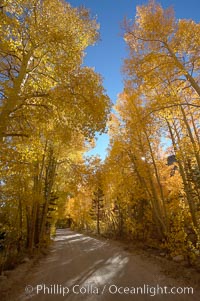
Aspen trees displaying fall colors rise alongside a High Sierra road near North Lake, Bishop Creek Canyon.
Species: Aspen, Populus tremuloides
Location: Bishop Creek Canyon, Sierra Nevada Mountains, California
Image ID: 17594
Species: Aspen, Populus tremuloides
Location: Bishop Creek Canyon, Sierra Nevada Mountains, California
Image ID: 17594
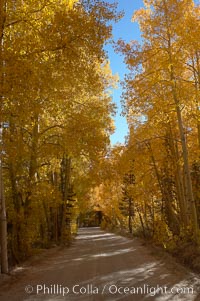
Aspen trees displaying fall colors rise alongside a High Sierra road near North Lake, Bishop Creek Canyon.
Species: Aspen, Populus tremuloides
Location: Bishop Creek Canyon, Sierra Nevada Mountains, California
Image ID: 17601
Species: Aspen, Populus tremuloides
Location: Bishop Creek Canyon, Sierra Nevada Mountains, California
Image ID: 17601